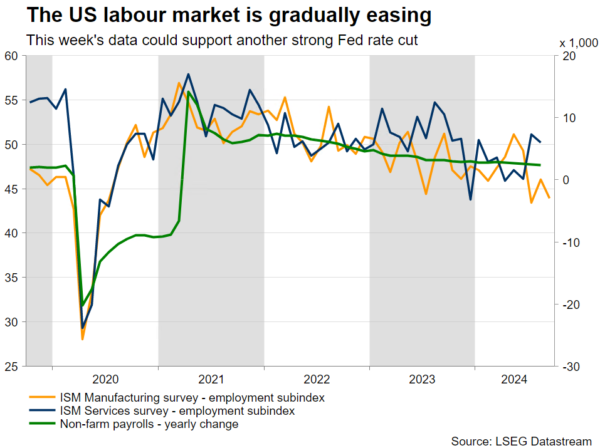- Discussions about the size of the November Fed rate cut continue
- Mixed labour market data up to now with ADP surprising on the upside
- Friday’s data matters the most; non-farm payrolls seen rising by 140k
- Geopolitics boost demand for dollar, data could reverse this trend
Fed rate cut discussions continue
With the market trying to figure out the next development in the Middle East and the likely market impact, the debate about the size of the November Fed rate cut continues. On Monday, Chairman Powell poured cold water on expectations by suggesting that the Fed would likely stick with 25bps rate cuts moving forward, with a total of 50bps of easing to be announced in the two remaining gatherings for 2024.
The Fed doves are not yet ready to accept defeat with the market still pricing in a sizeable 36% probability for a 50bps move in early November. However, with the economy progressing well, the housing market showing signs of life and core inflation remaining comfortably north of 3%, the bears face an enormous task to gather enough votes at the next FOMC meeting in order to achieve a second consecutive 50bps rate cut.
Having said that, since Powell’s Jackson Hole speech in late August, the labour market has become the crucial factor in the Fed’s decision-making process. This is not odd since the Fed operates with a dual mandate of price stability and full employment, contrary to the ECB’s single target of price stability. As such, the incoming labour market data, primarily Friday’s non-farm payrolls figure, could put the option of another aggressive rate cut back on the table.
Mixed US labor market data up to now
Despite the positive JOLTS job opening figure, both the ISM and PMI manufacturing surveys remain comfortably below the 50 threshold. Additionally, their respective employment subcomponents have resumed their recent downward trend, thus bringing some smiles to the doves’ faces.
However, these smiles have probably disappeared following yesterday’s ADP employment report. It managed to produce a small upside surprise by posting a 143k increase, above the market forecasts for an 120k jump, with the August number also getting a small upwards revision. However, both the Fed doves and market participants should be cautious as the ADP employment figure tends to be a very weak predictor of the non-farm payrolls print.
Key data today, but the focus is on Friday’s calendar
Today’s monthly Challenger job cuts, the weekly jobless claims and, predominantly, the ISM and PMI services surveys should serve as the best appetizer for Friday’s data. Another set of weak prints today will add to the current theme of a labour market weakness, and possibly force economists to lower their forecasts for tomorrow’s data.
Economists are currently looking for a 140k increase in the non-farm payrolls figure with both the unemployment rate and the average hourly earnings growth seen stable at 4.2% and 3.8% respectively. Confirmation of these expectations or an upside surprise, particularly in non-farm payrolls, would temporarily pause the discussion for a 50bps rate cut on November 7, with the doves hoping that the next set of labour market data in early November is more favourable to their case.
However, a sub-100k print tomorrow, a downward revision to August’s non-farm payrolls figure and an abrupt increase in the unemployment rate could support arguments for a 50bps rate cut in November, with the doves quickly appearing on the newswires to support such a move.
Dollar could underperform upon a weak set of data
The geopolitics-induced risk-off reaction has boosted the US dollar with the euro/dollar pair dropping towards the 1.1030 region and dollar/yen recovering abruptly. Assuming that there is no further escalation in the Middle East, weak labour market data on Friday will keep the discussion alive for another 50bps rate cut in November, and thus potentially reverse the current dollar/yen upleg. The 142.49 level is probably the plausible target for the dollar bears.
On the flip side, an upside surprise in the non-farm payrolls figure and a likely acceleration in the hourly earnings could help the dollar maintain its recent gains. A break above the busy 146.65-147.71 area could open the door for a more protracted rally in dollar/yen.














